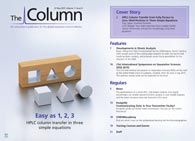Miniaturized High-Performance Chiral Liquid Chromatography
Stereoisomers of chiral compounds - two different forms (isomers) that are identical in composition but are non‑superimposable mirror images of one another - can have dramatically different effects in the human body making it important to ensure the purity of enantiomeric mixtures produced in drug development.
Photo Credit: Westend61/Getty Images

Stereoisomers of chiral compounds - two different forms (isomers) that are identical in composition but are nonâsuperimposable mirror images of one another - can have dramatically different effects in the human body making it important to ensure the purity of enantiomeric mixtures produced in drug development. A new study published in the journal Analytical Chemistry outlines a highâperformance chiral liquid chromatography method using polysaccharide-based chiral stationary phases (CSPs) in microfluidic chips for the analysis of pharmaceutical compounds that could improve the speed of separations and reduce solvent consumption.1
Miniaturization of chromatographic systems has become a key trend in the field of separation science, because it can speed up separations and reduce the volume of sample and solvent used. Alongside this the proportion of new drugs introduced to the market with chiral properties continues to increase, creating a demand for faster separation and analysis methods in the pharmaceutical industry. In this study, the authors designed a microfluidic glass chip with a column packed with CSP that allowed directed analyte injection onto the on-chip chromatographic column. According to the paper, more than 300 chromatography runs were performed without any change in performance and common HPLC pumps could be used. The separation of two enantiomers of trifluotonthrylethanol was reported to be achieved within 15 s; 6-hydroxyflavanone within 3.7 min; and 6-methoxyflavanone within 2 min. Separation times were reduced down to 5 s with a total analysis time of 15 s. Corresponding author of the study Detlev Belder told The Column that the main advantages of the approach were improved separation speeds, minimal sample and solvent consumption, and negligible dead volume.
Belder told The Column: “One of our research foci is the integration of enantioselective catalytic processes and analytical characterization on a single chip device, for high speed catalyst screening. In this context the realization ‘chiral Chip-HPLC’ is a key element for the realization of complex integrated chemical chip laboratories.”
When asked about future work, Belder said that the next steps will aim to further integration of functionalities on a chip, giving the example of adding a flow reactor with chiral HPLC for screening enantioselective catalysts. He said: “We are about to establish a research unit in the Leipzig [Germany] area bringing together synthetic and analytic chemists with the intention to evaluate the potential of integrated chemical microâlaboratories in a broader context.” - B.D.
Reference
S. Thurmann, C. Lotter, J.J. Heiland, B. Chankvetadze, and D. Belder, Analytical Chemistry DOI: 10.1021/acs.analchem.5b00210 (2015).
This news story was featured in The Column. Click here to view the full issue>>

A Matrix-Matched Semiquantification Method for PFAS in AFFF-Contaminated Soil
Published: April 14th 2025 | Updated: April 14th 2025Catharina Capitain and Melanie Schüßler from the Faculty of Geosciences at the University of Tübingen, Tübingen, Germany describe a novel approach using matrix-matched semiquantification to investigate per- and polyfluoroalkyl substances (PFAS) in contaminated soil.
Silvia Radenkovic on Building Connections in the Scientific Community
April 11th 2025In the second part of our conversation with Silvia Radenkovic, she shares insights into her involvement in scientific organizations and offers advice for young scientists looking to engage more in scientific organizations.










